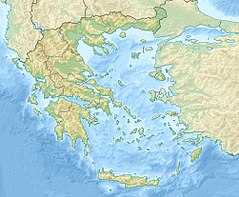Theopetra Cave is a limestone cave located in Theopetra village of Meteora municipality, Thessaly, Greece. It is situated on the northeast side of a limestone rock formation that is 3 km (2 mi) south of Kalambaka.[1] The site has become increasingly important as human presence is attributed to all periods of the Middle and Upper Paleolithic, the Mesolithic, Neolithic and beyond, bridging the Pleistocene with the Holocene.[2]
 The interior of the cave | |
| Location | 3 km (2 mi) south of Kalambaka |
|---|---|
| Region | Thessaly, Greece |
| Coordinates | 39°40′56.968″N 21°40′54.876″E / 39.68249111°N 21.68191000°E |
| Altitude | 300 m (984 ft) |
| Area | 500 m2 (5,382 sq ft) |
| Site notes | |
| Excavation dates | 1987–2002, 2005–2008 |

Description
editRadiocarbon evidence shows for human presence at least 50,000 years ago.[2] Excavations began in 1987 under the direction of Ν. Kyparissi-Apostolika, which were meant to answer questions about Paleolithic Thessaly.
Several features of the cave indicate human occupation.[3][4]
Theopetra Cave contains one of the longest archaeological sequences in Greece, comprising Middle and Upper Palaeolithic as well as Mesolithic and Neolithic cultural remains.[5][6][7] The records have shown important palaeoenvironmental data based on sedimentary features and botanical remains.[8]
Findings include a man-made stone wall that is still standing today, which was built in approximately 21,000 BCE. It is the oldest known example of a man-made structure.[9] The wall is thought to have been built to protect its residents from cold winds at the height of the last ice age.
Geologically, the formation of the limestone rock has been dated to the Upper Cretaceous period, 135–65 million years BP.[10][11]
Archaeogenetics
editIn 2016, researchers successfully extracted the DNA from the tibia of two individuals buried in Theopetra Cave. Both individuals were found in a Mesolithic burial context and separately dated to 7288–6771 BCE and 7605–7529 BCE. Both individuals were found to belong to mtDNA Haplogroup K1c.[12]
Access
editThe cave is located just to the north, within walking distance, of the center of Theopetra village. The Theopetra Cave Museum (Greek: Μουσείο Σπηλαίου Θεόπετρας) is located in the village.
Nearby, the ruins of the Monastery of St. Theodore (39°39′49″N 21°41′41″E / 39.663677°N 21.694746°E) are located just to the south of Theopetra village, near the village of Agii Theodori (Άγιοι Θεόδωροι).
References
edit- ^ Karkanas, Panagiotis; White, Dustin; Lane, Christine S.; Stringer, Chris; Davies, William; Cullen, Victoria L.; Smith, Victoria C.; Ntinou, Maria; Tsartsidou, Georgia; Kyparissi-Apostolika, Nina (June 2015). "Tephra correlations and climatic events between the MIS6/5 transition and the beginning of MIS3 in Theopetra Cave, central Greece". Quaternary Science Reviews. 118: 170–181. Bibcode:2015QSRv..118..170K. doi:10.1016/j.quascirev.2014.05.027.
- ^ a b Yorgos Facorellis; Nina Kyparissi-Apostolika; Yannis Maniatis (2001). "The cave of Theopetra, Kalambaka: Radiocarbon evidence for 50,000 years of human presence". Radiocarbon. 43 (2B): 1029–1048. doi:10.1017/s0033822200041692. Retrieved 11 January 2017.
"alternate copy" (PDF). Facorellis et alii. (2001). "The cave of Theopetra, Kalambaka". Radiocarbon, 43 (2B), 1029–1048. - ^ Facorellis, Yorgos; Kyparissi-Apostolika, Nina; Maniatis, Yannis (2001). "The Cave of Theopetra, Kalambaka: Radiocarbon Evidence for 50,000 Years of Human Presence". Radiocarbon. 43 (2B): 1029–1048. doi:10.1017/S0033822200041692. S2CID 59415809.
- ^ "The Theopetra Cave in Thessaly: A 130,000 year old prehistory (Part 1)". 5 October 2015.
- ^ Kyparissi-Apostolika N. (1998). "The Significance of Theopetra Cave for Greek Prehistory". Préhistoire d' Anatolie Genèse de Deux Mondes. pp. 241–252.
- ^ Kyparissi-Apostolika N. (1999). "The Palaeolithic deposits of Theopetra Cave in Thessaly (Greece)". The Palaeolithic Archaeology of Greece and Adjacent Areas. pp. 232–239.
- ^ Panagopoulou E. (1999). "The Theopetra middle palaeolithic assemblages: Their relevance to the middle palaeolithic of Greece and adjacent areas". Proceedings of the 1st International Conference on the Palaeolithic of Greece and Adjacent Areas (ICOPAG). Athens, Greece: British School at Athens: 252–265.
- ^ Tsartsidou, Georgia; Karkanas, Panagiotis; Marshall, Gilbert; Kyparissi-Apostolika, Nina (13 March 2014). "Palaeoenvironmental Reconstruction and Flora Exploitation at the Palaeolithic Cave of Theopetra, Central Greece: The evidence from phytolith analysis" (PDF). Archaeological and Anthropological Sciences. 7 (2): 169–185. doi:10.1007/s12520-014-0183-6. S2CID 129431281.
- ^ Chasiotis, Kostas (2014-01-15). "Theopetra Cave, a 130,000 years old prehistoric site". Visit Meteora. Retrieved 2022-07-06.
- ^ Ardaens, E. (1978). Geologie de la chaine du Vardussia, comparaison avec le massif du Koziakas (Grèce Continentale) (in French). Lille, France: Th è se 3 è me cycle.
- ^ Karkanas, P. (1999). Lithostratigraphy and micromorphology of Theopetra cave deposits, Thessaly, Greece: Some preliminary results. Vol. 3. Athens, Greece: Studies of the British School at Athens. pp. 240–251.
- ^ Hofmanová, Zuzana; Kreutzer, Susanne; Hellenthal, Garrett; Sell, Christian; Diekmann, Yoan; Díez-del-Molino, David; van Dorp, Lucy; López, Saioa; Kousathanas, Athanasios; Link, Vivian; Kirsanow, Karola; Cassidy, Lara M.; Martiniano, Rui; Strobel, Melanie; Scheu, Amelie; Kotsakis, Kostas; Halstead, Paul; Triantaphyllou, Sevi; Kyparissi-Apostolika, Nina; Urem-Kotsou, Dushka; Ziota, Christina; Adaktylou, Fotini; Gopalan, Shyamalika; Bobo, Dean M.; Winkelbach, Laura; Blöcher, Jens; Unterländer, Martina; Leuenberger, Christoph; Çilingiroğlu, Çiler; Horejs, Barbara; Gerritsen, Fokke; Shennan, Stephen J.; Bradley, Daniel G.; Currat, Mathias; Veeramah, Krishna R.; Wegmann, Daniel; Thomas, Mark G.; Papageorgopoulou, Christina; Burger, Joachim (2016). "Early farmers from across Europe directly descended from Neolithic Aegeans". Proceedings of the National Academy of Sciences. 113 (25): 6886–6891. doi:10.1073/pnas.1523951113. ISSN 0027-8424. PMC 4922144. PMID 27274049.
